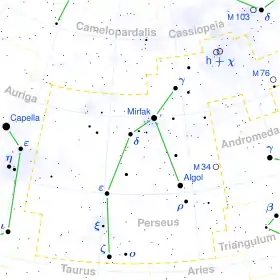1 Aurigae
1 Aurigae is the original name for a star now in the constellation Perseus. It was the first entry in John Flamsteed's catalogue of stars in Auriga. When Eugène Joseph Delporte drew up simplified boundaries for the constellations on behalf of the International Astronomical Union in 1930, 1 Aurigae ended up over the border in Perseus. To avoid confusion, the star may instead be referred to by its Harvard Revised catalogue number, HR 1533.
| Observation data Epoch J2000 Equinox J2000 | |
|---|---|
| Constellation | Perseus |
| Right ascension | 04h 49m 54.63946s[1] |
| Declination | 37° 29′ 17.7936″[1] |
| Apparent magnitude (V) | 4.89[2] |
| Characteristics | |
| Spectral type | K3.5IIIBa0.2:[3] |
| U−B color index | +1.71[4] |
| B−V color index | +1.45[4] |
| Astrometry | |
| Radial velocity (Rv) | −24.65[5] km/s |
| Proper motion (μ) | RA: −36.89[1] mas/yr Dec.: +38.85[1] mas/yr |
| Parallax (π) | 6.48 ± 0.44[1] mas |
| Distance | 500 ± 30 ly (150 ± 10 pc) |
| Absolute magnitude (MV) | −1.04[2] |
| Details | |
| Mass | 1.49[6] M☉ |
| Radius | 44±5[7] R☉ |
| Luminosity | 561[2] L☉ |
| Surface gravity (log g) | 1.12[8] cgs |
| Temperature | 4,102[8] K |
| Metallicity [Fe/H] | −0.30[8] dex |
| Rotational velocity (v sin i) | 1.6[9] km/s |
| Age | 3.93[6] Gyr |
| Other designations | |
| Database references | |
| SIMBAD | data |
Based upon its parallax measurement of 6.48 mas, this star is located approximately 520 light years from Earth.[1] It is visible to the naked eye as a faint, orange-hued star with an apparent visual magnitude of 4.89.[2] 1 Aurigae is moving closer to the Earth with a heliocentric radial velocity of −25 km/s.[5]
This is a possible binary star[11] system, based upon the status of the visible component as a mild barium star.[12] The primary is an aging giant star with a stellar classification of K3.5 III Ba0.2:.[3] It is 3.9[6] billion years old with 1.49[6] times the mass of the Sun and around 44[7] times the Sun's radius. This star is radiating 561[2] times the luminosity of the Sun from its enlarged photosphere at an effective temperature of 4,102 K.[8] The suspected companion star should be a white dwarf that previously transferred s-process elements to the visible member.[12]
References
- Van Leeuwen, F. (2007). "Validation of the new Hipparcos reduction". Astronomy and Astrophysics. 474 (2): 653. arXiv:0708.1752. Bibcode:2007A&A...474..653V. doi:10.1051/0004-6361:20078357. Vizier catalog entry
- Anderson, E.; Francis, Ch. (2012). "XHIP: An extended hipparcos compilation". Astronomy Letters. 38 (5): 331. arXiv:1108.4971. Bibcode:2012AstL...38..331A. doi:10.1134/S1063773712050015. Vizier catalog entry
- Hoffleit, D.; Warren, W. H. (1995). "VizieR Online Data Catalog: Bright Star Catalogue, 5th Revised Ed. (Hoffleit+, 1991)". VizieR On-line Data Catalog: V/50. Originally Published in: 1964BS....C......0H. 5050. Bibcode:1995yCat.5050....0H.
- Mermilliod, J. C. (2006). "VizieR Online Data Catalog: Homogeneous Means in the UBV System (Mermilliod 1991)". VizieR On-line Data Catalog: II/168. Originally Published in: Institut d'Astronomie. 2168. Bibcode:2006yCat.2168....0M.Vizier catalog entry
- Famaey, B.; Jorissen, A.; Luri, X.; Mayor, M.; Udry, S.; Dejonghe, H.; Turon, C. (2005). "Local kinematics of K and M giants from CORAVEL/Hipparcos/Tycho-2 data". Astronomy & Astrophysics. 430: 165. arXiv:astro-ph/0409579. Bibcode:2005A&A...430..165F. doi:10.1051/0004-6361:20041272.
- Luck, R. Earle (2015), "Abundances in the Local Region. I. G and K Giants", Astronomical Journal, 150 (3), 88, arXiv:1507.01466, Bibcode:2015AJ....150...88L, doi:10.1088/0004-6256/150/3/88.
- van Belle, G. T.; et al. (2009). "Supergiant temperatures and linear radii from near-infrared interferometry". Monthly Notices of the Royal Astronomical Society. 394 (4): 1925. arXiv:0811.4239. Bibcode:2009MNRAS.394.1925V. doi:10.1111/j.1365-2966.2008.14146.x.
- Earle Luck, R. (2014). "Parameters and Abundances in Luminous Stars". The Astronomical Journal. 147 (6): 137. Bibcode:2014AJ....147..137L. doi:10.1088/0004-6256/147/6/137.
- De Medeiros, J. R.; Mayor, M. (1999). "A catalog of rotational and radial velocities for evolved stars". Astronomy and Astrophysics Supplement Series. 139 (3): 433. arXiv:astro-ph/0608248. Bibcode:1999A&AS..139..433D. doi:10.1051/aas:1999401. Vizier catalog entry
- "1 Aur". SIMBAD. Centre de données astronomiques de Strasbourg. Retrieved 2019-03-30.
- Eggleton, P. P.; Tokovinin, A. A. (September 2008). "A catalogue of multiplicity among bright stellar systems". Monthly Notices of the Royal Astronomical Society. 389 (2): 869–879. arXiv:0806.2878. Bibcode:2008MNRAS.389..869E. doi:10.1111/j.1365-2966.2008.13596.x.
- Escorza, A.; et al. (December 2017). "Hertzsprung-Russell diagram and mass distribution of barium stars". Astronomy & Astrophysics. 608: 13. arXiv:1710.02029. Bibcode:2017A&A...608A.100E. doi:10.1051/0004-6361/201731832. A100.
